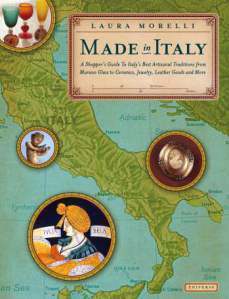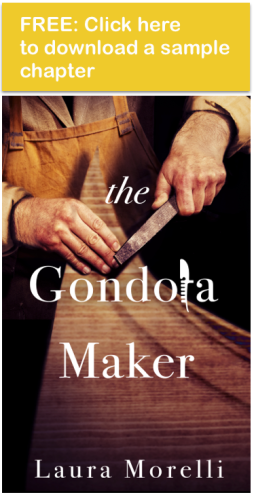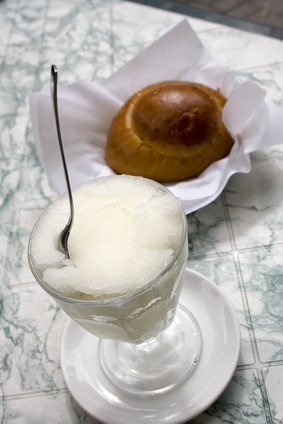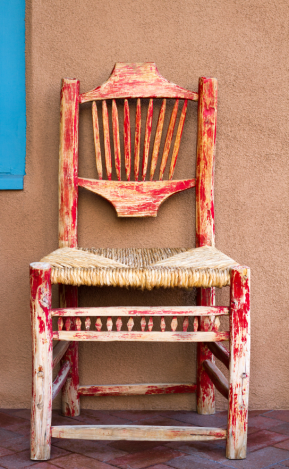Laura Morelli's Blog, page 9
September 5, 2014
The History of the Venetian Gondola: A New Video Lesson for TED-Ed
Venetian gondola, ca. 1689
It’s hard to imagine Venice without the curious, banana-shaped gondolas that glide down the canals. How did these boats come to be the trademark transportation of Venice? In this lesson for TED-Ed, I detail the history of the gondola, explaining why these boats were needed, the painstaking process by which they were made and why they have slowly begun to fade from the once-crowded canals. Have a look:
I welcome your thoughts on this topic!
The original TED-Ed lesson can be found here.








August 28, 2014
A Venetian gondola in America
Earlier this week I made a special trip to the Mariner’s Museum in Newport News, Virginia to see a Venetian gondola that the museum conserves in its collection.

This gondola dates from the mid-1800s, making it one of the oldest surviving Venetian gondolas today. (Unfortunately the humid environment of the Venetian canals and lagoon mean that wooden boats are essentially ephemeral, even ones of the highest order of craftsmanship.) This gondola may have been constructed around 1850 in the now-defunct Casal boatyard.
During a stay in Venice in 1890, the American painter Thomas Moran hired this gondola to ferry himself, his wife, and children around the city. At the time, people said that the boat had been owned or used by the British poet Robert Browning. Whether or not this connection added to the allure of the craft for Moran, the celebrated landscape painter became enamored with the idea of returning home with this remarkable “souvenir.” He purchased the gondola from its gondolier and arranged for it to be shipped to New York.

Later Moran wrote, “The gondola was so beautiful and graceful, and so ancient and fine in its carvings, brasses and fittings that we fell in love with it, and decided to have it sent to our Long Island house.” Moran was later seen steering on the boat on Hook Pond in East Hampton while enjoying picnic lunches with his family.
In 1926 Moran’s daughter donated the gondola to the East Hampton Library, who displayed it on their front lawn for a few decades, before realizing that it required more assiduous conservation. The gondola was donated to the Mariner’s Museum in 1950. It also made a brief visit to the National Gallery of Art in Washington, DC during the exhibition Venice: Canaletto and His Rivals, in 2011.

The boat measures about 37 feet long, and includes two carved wooden chairs upholstered in leather, as well as brass sea horses. It originally had a separate passenger compartment or felze, and I would like to know what happened to it as it is an integral part of the boat’s original appearance. (Passenger compartments disappeared only in the twentieth century when tourist traffic in Venice made it more convenient and desirable to travel in convertible boats.)
In 1998, the assistant curator for small craft at the museum, Chandi Singer, accompanied this boat back to Venice to be restored. The Tramontin family, who runs one of the last operating squeri (historic boatyards) in Venice, brought the boat back to its original beauty over the course of a two-month restoration. The eldest Tramontin brothers apprenticed at the Casal boatyard where this boat may have been made. How great is that?

In addition to the gondola, the Mariner’s Museum contains many other fascinating objects related to maritime history. A colorful display of historic figureheads caught my attention, as well as a dramatically lit exhibition of wooden model boats that includes an intricately carved Venetian galleass of the type that would have been constructed in the Venetian state shipyard, the Arsenale, in the seventeenth century.

I am happy to see this important gondola so beautifully conserved. Thanks to its care in the museum, it is likely to be preserved for future generations to appreciate.
Click here for more information about The Gondola Maker and click here to download a sample chapter.
Click here to visit Laura Morelli’s author page at amazon.








August 22, 2014
The Timeless Traditions of Catalan Ceramics
 Barcelona epitomizes the colorful, playful spirit of the artists Miró, Picasso, Dalí, and Gaudí, all of whom lived and worked here. The city is one of my favorite spots in Europe, a true shopper’s and art-lover’s paradise. Bedazzled by Barcelona’s modern delights, many visitors overlook the much older artistic heritage of Catalonia, the city’s rural hinterland, including one of its most deep-rooted traditions: pottery.
Barcelona epitomizes the colorful, playful spirit of the artists Miró, Picasso, Dalí, and Gaudí, all of whom lived and worked here. The city is one of my favorite spots in Europe, a true shopper’s and art-lover’s paradise. Bedazzled by Barcelona’s modern delights, many visitors overlook the much older artistic heritage of Catalonia, the city’s rural hinterland, including one of its most deep-rooted traditions: pottery.
Photo: Hispano-Moresque ware from Valencia, Spain (Marshall Colman Marshall46, CC-BY-SA-3.0, via Wikimedia Commons)
Catalan pottery (terrissa catalana in Catalan language) traces its legacy to prehistoric times, thanks to an abundance of high-quality clay in the hills wedged along the northeastern Spanish coast bordering France. Archeologists have discovered decorated ceramic fragments dating back some 7,000 years. Iberian, Roman, and later, Moorish artisans built kilns to fire utilitarian pots now displayed by the thousands in regional museums.
Read more of Laura Morelli’s “The Genuine Article” at National Geographic Traveler…








August 19, 2014
Saris, Skirts and More from Rajasthan
 I am thrilled to open my mailbox and find a dinner party invitation from a certain Indian friend. She’s a fabulous cook and my mouth waters to think of her cumin-tinged roasted eggplant. But mostly, I’m eager to see what she’s wearing.
I am thrilled to open my mailbox and find a dinner party invitation from a certain Indian friend. She’s a fabulous cook and my mouth waters to think of her cumin-tinged roasted eggplant. But mostly, I’m eager to see what she’s wearing.
Invariably, she greets us in a richly hued sari so stunning that it leaves her dinner guests feeling utterly unimaginative. This time it’s embellished with embroidered swirls and tiny reflective mirrors, the kind of textile decoration associated with her native Rajasthan, a partially desert region bordering Pakistan.
Photo: Peter Barker via Flickr
Indian textiles count among the richest craft legacies on Earth, encompassing literally thousands of local styles and techniques. Textiles from Rajasthan represent an entire tradition with many sub-specialties, from wood-block prints to tie-dyed cottons and a litany of embroidery techniques long enough to fill a glossary of their own. Through the centuries these rich regional fabrics have constituted a valuable part of women’s wedding trousseaus and dowries, identified social status and class…
Read more of Laura Morelli’s “The Genuine Article” at National Geographic Traveler…








August 13, 2014
Are you left-handed?
Happy Left-Handers Day if you are!
As the mother of three left-handed children, I am fascinated by left-handedness. During the course of my research for The Gondola Maker, I read a lot about how left-handed people were perceived in past centuries. In the story of The Gondola Maker, Luca’s left-handedness plays a crucial role in the story. It informs his self-image, his relationship with his father, and his destiny as a master craftsman. Read on…
Excerpted from The Gondola Maker:
One of my earliest memories was overhearing a neighbor woman whisper that the gondola maker’s eldest son was marked by the devil. My father must have believed it, as he did his best to undo my curse. In the boatyard, I was not allowed to pick up tools with my left hand. I lived for most of a year with my left hand tied behind my back during my hours in the boatyard, untied only at mealtime. Even now, I feel the knuckles of my left hand tingle when my father raises his voice.
It was my mother who taught me to temper my ever-present compulsion to use my sinister hand, as she herself had had to do. At the table and in our parish church, she had squeezed my left hand tightly while teaching me to make the sign of the cross with my right. In public, she instructed me to sit on my left hand, or keep it in my pocket; in private, she reminded me that the left hand was the “hand of the heart.” At night she nursed my knuckles, bruised and swollen from where my father had struck them with a rasp each time I had reached for an implement.
I never mastered the tools with my right hand nearly as well as with my left. Eventually, Father gave up trying to force me to use my “correct” hand in the boatyard, and assigned many of the duties that the eldest son might be expected to do to my brother, who is gifted with dexterity and unmarked by Satan. My uncle and cousins mercifully turned a blind eye to my affliction, and my brother loved me anyway. I did what I could to make beautiful and seaworthy boats, just like my father and grandfather. Our work carried on.
Click here for more information about the award-winning novel, The Gondola Maker, and click here to download a sample chapter.
Click here to visit Laura Morelli’s author page at amazon.








August 11, 2014
Granita: Sicily’s Frozen Treat
 Every year when August rolls around, I start dreaming of Sicily, and especially of its distinctive frozen treat: granita. Sicily excels in frozen treats, and it’s no wonder. The summer on this beautiful island is hot indeed, and air conditioning is not widely available. I once spent the entire month of August on Sicily, and I can vouch for the intense heat that overtakes Italy’s largest island.
Every year when August rolls around, I start dreaming of Sicily, and especially of its distinctive frozen treat: granita. Sicily excels in frozen treats, and it’s no wonder. The summer on this beautiful island is hot indeed, and air conditioning is not widely available. I once spent the entire month of August on Sicily, and I can vouch for the intense heat that overtakes Italy’s largest island.
There’s nothing like the taste of a cone overflowing with Sicilian gelato, among the richest and sweetest in Italy. But to cool your body down quickly, I prefer granita, a shaved ice slushy made with fresh fruit and a little sugar.
Granita comes in every flavor imaginable, from kiwi to coffee, lemon, mint, and strawberry. My favorite flavors are watermelon and lemon. Almond granita is the ultimate Sicilian granita flavor, though. It seems that there is nothing Sicilians can’t make with almonds! A popular summer breakfast in Sicily involves a freshly baked brioche served with almond granita.
Different parts of Sicily claim different types of granita. Messina, on Sicily’s northeastern coast, is famous for its granita al caffè. Catania is known for its delicious pistachio-flavored granita. According to many Sicilians, the eastern part of the island makes their granite more liquid, while the consistency of this sweet treat becomes more granular as you move west.
While commercial slushy machines have become more common, there’s nothing like freshly hand-shaven granita in a glass dish. Old-fashioned granita makers use the stainless steel ice scrapers that have been around since the time of our grandparents. Hard to beat!
If you want to make your own Sicilian granita, all you need to do is throw some fresh fruit in a blender with a tiny bit of water and sugar. Once pureed, pour it into a pan and freeze it. Every half-hour or so, scrape the surface with a spoon or fork until the mixture is crystalline.
Whether you’re enjoying your granita in Sicily or wherever you call home, salute! And happy summer!
Related: How to find good limoncello even if you’re not going to Sorrento.
For more of my tips on authentic shopping in Italy, click here.








August 7, 2014
Sound Check!
 I’m excited to be back in the sound studio today, recording narration for a new TED-Ed lesson!
I’m excited to be back in the sound studio today, recording narration for a new TED-Ed lesson!
The new lesson is about Venetian gondolas, a topic near and dear to my heart, needless to say!
Stay tuned for updates. You’ll be the first to know when the lesson goes live on the TED-Ed website and YouTube channel.
Meanwhile…
Is there a difference between art and craft, and if so, what is it? Have a look at my TED-Ed lesson and let me know your thoughts:
The original TED-Ed lesson can be found here. Thanks for watching!
August 6, 2014
Golden Day 118: Faenza with Laura Silvagni of Ceramiche La Vecchia Faenza
Many thanks to my friend and fellow Italophile, Susan van Allen!
 Originally posted on Golden Days in Italy:
Originally posted on Golden Days in Italy:
 I discovered the Superstar Ceramicist Laura Silvagni while reading Laura Morelli’s wonderful book, Made in Italy, a MUST READ for anyone interested in the backstage story of Italian artisans.
I discovered the Superstar Ceramicist Laura Silvagni while reading Laura Morelli’s wonderful book, Made in Italy, a MUST READ for anyone interested in the backstage story of Italian artisans.
One of the many artisans Made in Italy features is Laura Silvagni, who is from the town of Faenza in Emilia-Romagna, a place that has been renowned for ceramics since the Renaissance.
 Of the many patterns Faenza is famous for, I love the Garofano (carnation style), that was inspired by French and Asian ceramics and became popular here in the 18th century.
Of the many patterns Faenza is famous for, I love the Garofano (carnation style), that was inspired by French and Asian ceramics and became popular here in the 18th century.
 Laura Silvagni brings a new interpretation of traditional Faenza designs to her work, that’s been praised internationally. Her hand painted ceramics have become part of prized private collections–including that of Pope John Paul II. She is well known for her hand painted Raffallesco pieces…
Laura Silvagni brings a new interpretation of traditional Faenza designs to her work, that’s been praised internationally. Her hand painted ceramics have become part of prized private collections–including that of Pope John Paul II. She is well known for her hand painted Raffallesco pieces…
You can find creations of Laura’s and other Faenza artisans at La Vecchia Faenza (Via…
View original 489 more words








August 5, 2014
Spanish Colonial Furniture of the American Southwest
A hand-hewn bench with knots along the grain. A rustic chest with hand-carved rosettes. A pine cupboard with tin panels. Understated, beautiful pieces of hand-crafted furniture play an important role in the region’s history and remain a vibrant part of the Southwest’s craft landscape. Today, even with modern furniture-making technology, these simple, rustic styles persist, deeply ingrained in the spirit of the Southwest.
The story of hand-crafted chairs, tables, trasteros, cajas, and other now-familiar furnishings in the region begins with the Colonial period, when Spanish settlers moved north along the Rio Grande to establish communities in what is now New Mexico. These early colonists were concerned first with survival in the harsh new land, and as a result, they valued function above all. These early pieces are simple, with blocklike forms and restrained carved decoration. As the communities became established, furniture craftsmen, as well as other craftspeople, organized themselves into specialized guilds, much like their ancestors from Spain, where the medieval guild system of trades was well entrenched in the society.
Click here to read the rest of this article at Su Casa Magazine.
For more on authentic shopping, click here.








July 18, 2014
How Romanization Worked
 Ampitheatre at El Djem, Tunisia, 238 CE
Ampitheatre at El Djem, Tunisia, 238 CE
When the ancient Romans conquered a new place, they swiftly romanized it by erecting monuments that were mirror images of those in their capital: an arena, triumphal arches, baths, basilicas, aqueducts, roads… Imperial statues were erected in city squares, portraying the likenesses of the Roman emperor as well as imperial governors in the guise of gods.
Strolling through the streets of a newly Romanized city, we can only imagine that locals must have felt a palpable and dominating presence of the far-away emperor.





























